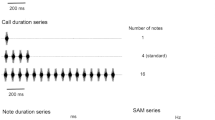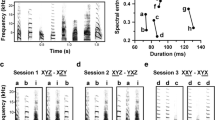Abstract
Female choice plays a critical role in the evolution of male acoustic displays. Yet there is limited information on the neurophysiological basis of female songbirds’ auditory recognition systems. To understand the neural mechanisms of how non-singing female songbirds perceive behaviorally relevant vocalizations, we recorded responses of single neurons to acoustic stimuli in two auditory forebrain regions, the caudal lateral mesopallium (CLM) and Field L, in anesthetized adult female zebra finches (Taeniopygia guttata). Using various metrics of response selectivity, we found consistently higher response strengths for unfamiliar conspecific songs compared to tone pips and white noise in Field L but not in CLM. We also found that neurons in the left auditory forebrain had lower response strengths to synthetics sounds, leading to overall higher neural selectivity for song in neurons of the left hemisphere. This laterality effect is consistent with previously published behavioral data in zebra finches. Overall, our results from Field L are in parallel and from CLM are in contrast with the patterns of response selectivity reported for conspecific songs over synthetic sounds in male zebra finches, suggesting some degree of sexual dimorphism of auditory perception mechanisms in songbirds.





Similar content being viewed by others
References
Amin N, Grace GA, Theunissen FE (2004) Neural response to bird’s own song and tutor song in the zebra finch field L and caudal mesopallium. J Comp Phsysiol A 190:469–489
Avey MT, Phillmore LS, MacDougall-Shackleton SA (2005) Immediate early gene expression following exposure to acoustic and visual components of courtship in zebra finches. Behav Brain Res 165:247–253
Bailey DJ, Wade J (2003) Differential expression of the immediate early genes FOS and ZENK following auditory stimulation in the juvenile male and female zebra finch. Mol Brain Res 116:147–154
Bailey DJ, Rosebush JC, Wade J (2002) The hippocampus and caudomedial neostriatum show selective responsiveness to conspecific song in the female zebra finch. J Neurobiol 52:43–51
Beecher MD, Brenowitz EA (2005) Functional aspects of song learning in birds. Trends Ecol Evol 20:143–149
Bolhuis JJ, Gahr M (2006) Neural mechanisms of birdsong memory. Nature Rev Neurosci 7:347–357
Braaten RF, Reynolds K (1999) Auditory preference for conspecific song in isolation-reared zebra finches. Anim Behav 58:105–111
Brenowitz E (1991) Altered perception of species-specific song by female birds after lesions of a forebrain nucleus. Science 251:303–305
Brenowitz EA, Beecher MD (2005) Song learning in birds: diversity and plasticity, opportunities and challenges. Trends Neurosci 28:127–132
Cardin JA, Schmidt MF (2003) Song system auditory responses are stable and highly tuned during sedation, rapidly modulated and unselective during wakefulness, and suppressed by arousal. J Neurophysiol 90:2884–2899
Coleman MJ, Mooney R (2004) Synaptic transformations underlying highly selective auditory representations of learned birdsong. J Neurosci 24:7251–7265
Cousillas H, Richard J-P, Mathelier M, Henry L, George I, Hausberger M (2004) Experience-dependent neuronal specialization and functional organization in the central auditory area of a songbird. Eur J Neurosci 19:3343–3376
Cousillas H, George I, Mathelier M, Richard J-P, Henry L, Hausberger M (2006) Social experience influences the development of a central auditory area. Naturwissenschaften 93:588–596
Cynx J, Williams H, Nottebohm F (1992) Hemispheric differences in avian song discrimination. Proc Natl Acad Sci USA 89:1372–1375
Dey DK, Ghosh SK, Mallick BK (eds) (2000) Generalized linear mixed models: a Bayesian perspective. Marcel Dekker Inc., Basel
Floody OR, Arnold AP (1997) Song lateralization in the zebra finch. Horm Behav 31:25–34
Fortune ES, Margoliash D (2004) Cytoarchitectonic organization and morphology of cells of the field L complex in male zebra finches (Taenopygia guttata). J Comp Neurol 325:388–404
Gehr DD, Capsius B, Grabner P, Gahr M, Leppelsack H-J (1999) Functional organisation of the field-L-complex of adult male zebra finches. Neuroreport 10:375–380
Gentner TZ, Margoliash D (2003) Neuronal populations and feature detectors representing learned auditory objects. Nature 424:669–674
George I, Cousillas H, Richard J-P, Hausberger M (2005) State-dependent hemispheric specialization in the songbird brain. J Comp Neurol 488:48–60
George I, Hara E, Hessler NA (2006) Behavioral and neural lateralization of vision in courtship singing of the zebra finch. J Neurobiol 66:1164–1173
Grace JA, Amin NA, Singh NC, Theunissen FE (2003) Selectivity for conspecific song in the zebra finch auditory forebrain. J Neurophysiol 89:472–487
Grim T (2006) Cuckoo growth performance in parasitized and unused hosts: not only host size matters. Behav Ecol Sociobiol 60:716–723
Grim T (2007) Experimental evidence for chick discrimination without recognition in a brood parasite host. Proc R Soc Lond B 274:373–381
Hauber ME, Sherman PW (2001) Self-referent phenotype matching: theoretical considerations and empirical evidence. Trends Neurosci 24:609–616
Hauber ME, Woolley SMN, Fremouw TE, Theunissen FE (2003) Response selectivity and tuning of auditory forebrain neurons in female zebra finches. Society for Neuroscience 34th Annual Meeting abstract, San Diego
Hauber ME, Woolley SMN, Theunissen FE (2006) Learning, memory and mate choice: early experience and neuronal discrimination of songs by female zebra finches. J Ornithol 147:S12
Hauser MD, Andersson K (1994) Left hemisphere dominance for processing vocalizations in adult, but not infant, rhesus monkeys: field experiments. Proc Natl Acad Sci USA 91:3946–3948
Hsu A, Woolley SMN, Fremouw T, Theunissen FE (2004) Modulation and phase spectrum of natural sounds enhance neural discrimination performed by single auditory neurons. J Neurosci 24:9201–9221
Hunt GR, Corballis MC, Gray RD (2001) Laterality in tool manufacture by crows. Nature 414:707
Kachman SD (2000) An introduction to generalized linear mixed models. Proceedings of a symposium at the organizational meeting for a NCR coordinating committee on “Implementation Strategies for National Beef Cattle Evaluation,” Athens, pp 59–73
Lauay C, Gerlach NM, Adkins-Regan E, Devoogd TJ (2004) Female zebra finches require early song exposure to prefer high-quality song as adults. Anim Behav 68:1249–1255
Lauay C, Komorowski RW, Beaudin AE, DeVoogd TJ (2005) Adult female and male zebra finches show distinct patterns of spine deficits in an auditory area and in the song system when reared without exposure to normal adult song. J Comp Neurol 487:119–126
Leppelsack HJ, Vogt M (1976) Responses of auditory neurons in the forebrain of a songbird to stimulation with species-specific sounds. J Comp Neurol 107:263–274
Littell RC, Milliken GA, Stroup WW, Wolfinger RD (1996) SAS system for mixed models. SAS Institute, Cary
MacDougall-Shackleton SA, Hulse SH, Ball GF (1998) Neural bases of song preferences in female zebra finches (Taeniopygia guttata). Neuroreport 9:3047–3052
MacDougall-Shackleton SA, Ball GF (1999) Comparative studies on sex differences in the song-control systems of songbirds. Trends Neurosci 22:432–436
Maney DL, MacDougall-Shackleton EA, MacDougall-Shackleton SA, Ball GF, Hahn TP (2003) Immediate early gene response to hearing song correlates with receptive behavior and depends on dialect in a female songbird. J Comp Physiol A 189:667–674
Maney DL, Cho E, Goode CT (2006) Estrogen dependent selectivity of genomic responses to birdsong. Euro J Neurosci 23:1523–1529
Miller DB (1979) Long-term recognition of father’s song by female zebra finches. Nature 280:389–391
Nottebohm F, Arnold AP (1976) Sexual dimorphism in vocal control areas of the songbird brain. Science 194:211–213
Palleroni A, Hauser MD (2003) Experience-dependent plasticity for auditory processing in a raptor. Science 299:1195
Phan ML, Pytte CL, Vicario DS (2006) Early auditory experience generates long-lasting memories that may subserve vocal learning in songbirds. Proc Natl Acad Sci USA 103:1088–1093
Poremba A, Malloy M, Saunders RC, Carson RE, Herscovitch P, Mishkin M (2004) Species-specific calls evoke asymmetric activity in the monkey’s temporal poles. Nature 427:448–451
Pytte CL, Suthers RA (1999) A bird’s own song contributes to conspecific song perception. Neuroreport 10:1773–1778
Reiner A, Perkel DJ, Bruce L, Butler AB, Csillag A, Kuenzel W, Medina L, Paxinos G, Shimizu T, Striedter GF, Wild M, Ball GF, Durand S, Gunturkun O, Lee DW, Mello CV, Powers A, White SA, Hough G, Kubikova L, Smulders TV, Wada K, Dugas-Ford J, Husband S, Yamamoto K, Yu J, Siang C, Jarvis ED (2004) Revised nomenclature for avian telencephalon and some related brainstem nuclei. J Comp Neurol 473:377–414
Riebel K (2000) Early exposure to song leads to repeatable preferences for male song in female zebra finches. Proc R Soc Lond B 267:2553–2558
Riebel K (2003) The ‘mute’ sex revisited: vocal production and perception learning in female songbirds. Adv Stud Behav 33:49–86
Riebel K (2003) Developmental influences on song perception in female zebra finches, Taeniopygia guttata: is there a sensitive phase for song preference learning? Anim Biol 53:73–87
Riebel K, Smallegange IM, Terpstra NJ, Bolhuis JJ (2002) Sexual equality in zebra finch song preference: Evidence for a dissociation between song recognition and production learning. Proc R Soc Lond B 269:729–733
Riebel K, Hall ML, Langmore NE (2005) Female songbirds still struggling to be heard. Trends Ecol Evol 20:419–420
Scheich H, Bonke D (1979) Responsiveness of units in the auditory neostriatum of the guineafowl (Numida meleagris). J Comp Phsyiol 132:257–276
Seddon N (2005) Ecological adaptation and species recognition drives vocal evolution in Neotropical suboscine birds. Evolution 59:200–215
Sockman KW, Gentner TQ, Ball GF (2002) Recent experience modulates forebrain gene-expression in response to mate-choice cues in European starlings. Proc R Soc Lond B 269:2479–2485
Terpstra NJ, Bolhuis JJ, den Boer-Visser AM, ten Cate C (2005) Neuronal activation related to auditory perception in a non-songbird. J J Comp Neurol 488:342–351
Terpstra NJ, Bolhuis JJ, Riebel K, van der Burg JMM, den Boer-Visser AM (2006) Localized brain activation specific to auditory memory in a female songbird. J Comp Neurol 494:784–791
Theunissen FE, Amin N, Shaevitz SS, Woolley SMN, Fremouw T, Hauber ME (2004) Song selectivity in the song system and in the auditory forebrain. Ann NY Acad Sci 1016:222–245
Tomaszycki ML, Sluzas EM, Sundberg KA, Newman SW, DeVoogd TJ (2006) Immediate early gene (ZENK) responses to song in juvenile female and male zebra finches: effects of rearing environment. J Neurobiol 66:1175–1182
Vates GE, Broome BM, Mello CV, Nottebohm F (1996) Auditory pathways of caudal telencephalon and their relation to the song system of adult male zebra finches. J Comp Neurol 366:613–642
Wild JM (1995) Convergence of somatosensory and auditory projections in the avian torus semicircularis, including the central auditory nucleus. J Comp Neurol 358:465–486
Williams H (1990) Models for song learning in the zebra finch: fathers or others. Anim Behav 39:745–757
Williams H, Crane LA, Hale TK, Esposito MA, Nottebohm F (1992) Right-side dominance for song control in the zebra finch. J Neurobiol 23:1006–1020
Woolley SMN, Casseday JH (2004) Response properties of single neurons in the zebra finch auditory midbrain: response patterns, frequency coding, intensity coding and spike latencies. J Neurophysiol 91:136–151
Woolley SMN, Casseday JH (2005) Processing of modulated sounds in the zebra finch auditory midbrain: responses to noise, frequency sweeps and sinusoidal amplitude modulations. J Neurophysiol 94:1143–1157
Woolley SMN, Fremouw TE, Hsu A, Theunissen FE (2005) Spectro-temporal modulation tuning as a mechanism for auditory discrimination of natural sounds. Nat Neurosci 8:1371–1379
Woolley SMN, Gill P, Theunissen FE (2006) Stimulus-dependent auditory tuning results in synchronized population coding of vocalizations in the songbird midbrain. J Neurosci 26:2499–2512
Yamaguchi A (2001) Sex differences in vocal learning in birds. Nature 411:257–258
Zann RA (1996) The zebra finch: a synthesis of field and laboratory studies. Oxford University Press, London
Zatorre RJ (2001) Neural specializations for tonal processing. Ann NY Acad Sci 930:193–210
Acknowledgments
All protocols were approved by institutional animal ethics committees and followed governmental guidelines. For assistance and discussions, we are grateful to N. Amin, T. Fremouw, T. Jonsson, F. Kubke, E. Lacey, P. Logerot, B. Raymond, S. Shaevitz, K. Sockman, M. Wild, and anonymous referees. This study was supported by grants from the National Institutes of Health (to FET), an NIH service award (to SMNW), and funding from the University of Auckland Research Council and the New Zealand Marsden Fund (to MEH).
Author information
Authors and Affiliations
Corresponding author
Rights and permissions
About this article
Cite this article
Hauber, M.E., Cassey, P., Woolley, S.M.N. et al. Neurophysiological response selectivity for conspecific songs over synthetic sounds in the auditory forebrain of non-singing female songbirds. J Comp Physiol A 193, 765–774 (2007). https://doi.org/10.1007/s00359-007-0231-0
Received:
Revised:
Accepted:
Published:
Issue Date:
DOI: https://doi.org/10.1007/s00359-007-0231-0




